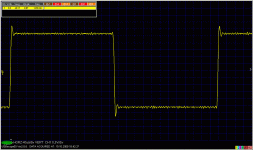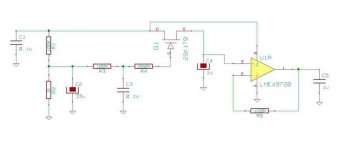Thank you, audiowilf.
Any suggestions for minimizing eddy currents in 0.25" aluminum enclosure?
Any suggestions for minimizing eddy currents in 0.25" aluminum enclosure?
Joshua_G said:The attached regulator above is intended to come in series to LM317 regulator.
John Wenzel's trick to noise cancel the LM317 is good (I forgot who archived it).
scott wurcer said:
John Wenzel's trick to noise cancel the LM317 is good (I forgot who archived it).
Is the attached schematic John Wenzel's trick?
Getting back to impulse response, the only measurement that I actually made was square wave response in my 30 ips mastering machines. In this case, it is possible to get a nearly perfect 10KHz sq wave with a 10us risetime. That is about the practical limit with normal mastering tape.
However, it is PRE-SHOOT, or some information arriving before the main signal, is what really bothers me with CD digital. That is unnatural, and I'm sure audible even in small amounts.
However, it is PRE-SHOOT, or some information arriving before the main signal, is what really bothers me with CD digital. That is unnatural, and I'm sure audible even in small amounts.
Joshua_G said:I wonder which regulator is quieter, yours or one like in the attached schematic.
Mine 😀
The one in the attached schematic will badly affect the load regulation of the PSU. The source follower has a much higher otput impedance than the LM317 output.
It may lower the noise a bit (don't bet on that, MOSFETs are very noisy devices), however:
A LM317 has typically has a RMS noise (in 10Hz-10KHz) of 0.003% of the output. For a 3.3V supply, this makes for 100uVrms, or a noise density of roughly 1000nV/rtHz. Compare to http://focus.ti.com/lit/ds/symlink/tps79133.pdf where the TPS79133 has a fllor noise of 120nV/rtHz, that is about an order of magnitude better.
Sorry Josh if the above required engaging your brain beyond it's capacity in the New Year's Eve. Here's something much easier to digest: even if the two solution would have identical performance (which is definitely not the case in the real world) compare the size/PCB space required and the costs. The LM317/MOSFET solution requires at least one sq. inch of PCB and would cost $7-$10 (more if you use Roederstein resistors
 ) in parts. The TPS79133 requires less than 0.1 sq. inch in PCB space and costs $1 in parts (including the output ceramic capacitor) plus some gray cells to design a good (RF and thermal) layout. Both about one order of magnitude better. Anno Domini 2009 vs. the 80's.
) in parts. The TPS79133 requires less than 0.1 sq. inch in PCB space and costs $1 in parts (including the output ceramic capacitor) plus some gray cells to design a good (RF and thermal) layout. Both about one order of magnitude better. Anno Domini 2009 vs. the 80's.Hope I didn't waste these 5 minutes.
Edit: Here's the Wenzel circuit for your reference: http://www.wenzel.com/documents/finesse.html It will lower the noise by tipically 24dB, bringing the thing under the TPS79133 noise range of 100nV/rtHz. But if you enjoy building such an ugly and expensive thing in 2009, it's your call.
PMA said:The same in CD mode, common 16/44.1 digital PCM response.
Let me change my white hat to black one and say, "square waves are not music". I could not find a non-anecdotal reference to the audibility of a 24kHz anti-aliasing filter. Apogee was modifying Sony PCM-F1's with ANALOG filters to produce "square" waves (their words) almost 25yrs ago.
Anyway Happy New Year.

Originally posted by syn08
The one in the attached schematic will badly affect the load regulation of the PSU. The source follower has a much higher otput impedance than the LM317 output.
Output impedance can be reduced – I drew only the basic idea.
Thank you for your complement. Highly appreciated.Originally posted by syn08
Sorry Josh if the above required engaging your brain beyond it's capacity in the New Year's Eve.
However, you seem to estimate yourself higher than you really are.
Originally posted by syn08
The LM317/MOSFET solution requires at least one sq. inch of PCB and would cost $7-$10 (more if you use Roederstein resistors) in parts. The TPS79133 requires less than 0.1 sq. inch in PCB space and costs $1 in parts (including the output ceramic capacitor) plus some gray cells to design a good (RF and thermal) layout. Both about one order of magnitude better. Anno Domini 2009 vs. the 80's.
I didn't speak about PCB estate and cost – only about noise.
Do you want to see a circuit much quieter than yours?
Juergen Knoop said:
what about ripple rejection? Worse than '317?
Where's progress?
regards
LM317 has about 80dB 100Hz ripple regulation at 5V drop. TPS79133 has 75dB 100Hz but at 0.7V drop. The progress is the LDO concept and BTW, if you want to use those 80dB, you better add the PCB space (and part cost to the BOM) of an onboard heatsink.
Edit: I trend to use TI solutions only because they are very generous in sampling. Much better LDO solutions exist, e.g. http://www.analog.com/static/imported-files/data_sheets/ADP3303.pdf which has almost 90dB ripple rejection or the equivalents from LT.
Joshua_G said:
Do you want to see a circuit much quieter than yours?
No thank you, I've already built a PSU with less than 10nV/rtHz noise: http://www.diyaudio.com/forums/showthread.php?postid=1678221#post1678221 first photo. At those levels, the wiring (force/sense and shielding) is the limitation. If you can do better (in the real world) let me know.
I don't need that for a 3.3V DAC power supply.
Happy New Year!
A LM317 has typically has a RMS noise (in 10Hz-10KHz) of 0.003% of the output. For a 3.3V supply, this makes for 100uVrms, or a noise density of roughly 1000nV/rtHz. Compare to http://focus.ti.com/lit/ds/symlink/tps79133.pdf where the TPS79133 has a fllor noise of 120nV/rtHz, that is about an order of magnitude better.
Is it wise to compare LM317 with 3-40V input voltage range with TPS79133 with 2.7-5.5V input voltage range?
dimitri said:
Is it wise to compare LM317 with 3-40V input voltage range with TPS79133 with 2.7-5.5V input voltage range?
I am talking here about a 3.3V supply for a DAC. For higher voltages, Linear Technology has a range of LDOs supporting 20-36V, with 75-80dB ripple rejection and 200-400 nV/rtHz noise all at well under 1V drop.
No, it is not fair to compare, but it was not me suggesting LM317 for such an application.
scott wurcer said:
Let me change my white hat to black one and say, "square waves are not music". I could not find a non-anecdotal reference to the audibility of a 24kHz anti-aliasing filter. Apogee was modifying Sony PCM-F1's with ANALOG filters to produce "square" waves (their words) almost 25yrs ago.
Anyway Happy New Year.

Music spectrum is normally spread to 30 - 40kHz. Sharp 21kHz cutt-off is against music nature, and you get something similar what you see from step response, as you know very well.
Anyway, Happy New Year as well 😉
syn08 said:
No thank you, I've already built a PSU with less than 10nV/rtHz noise: http://www.diyaudio.com/forums/showthread.php?postid=1678221#post1678221 first photo. At those levels, the wiring (force/sense and shielding) is the limitation. If you can do better (in the real world) let me know.
I don't need that for a 3.3V DAC power supply.
Happy New Year!
Below is my PSU.
It can be made much quieter.
For the analog part of the DAC IC, the quieter the supply, the better the sound.
Happy New Year.
Attachments
that's a unique design.Joshua_G said:
Below is my PSU.
....
Happy New Year.
I think one of the masters of sim can help you to change it.
I don't have the LME' to build a prototype and armchair recommondations won't help you.
Happy New Year too!!

- Status
- Not open for further replies.
- Home
- Amplifiers
- Solid State
- John Curl's Blowtorch preamplifier


